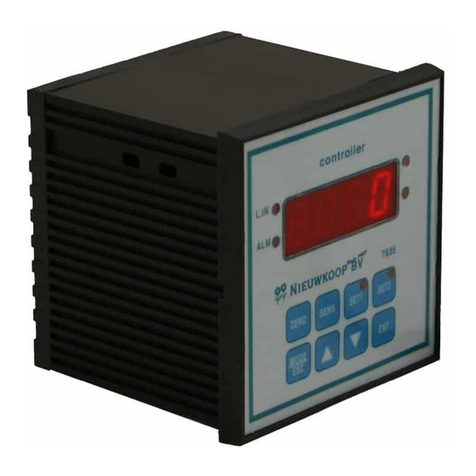
EC3020
CONDUCTIVITY CONTROLLER, MICROPROCESSOR BASED
_____________________________________________________________________________________________
1
Conductivity scales : from 0/0.2000 µS tot 0/40.00 S
Temperature scale : -10/110 ˚C
Power supply : 110/220 Vac
Software
: R 2.1x
Valid also for option : P/N 091.3713
Cod. 28003763
Rev. D –10/18
INDEX
1 GENERAL WARNINGS AND INFORMATION FOR ALL USERS.............................................................................................................................3
1.1 WARRANTY.......................................................................................................................................................................................................................................3
1.2 AFTER SALES SERVICE............................................................................................................................................................................................................3
1.3 CE MARKING ...................................................................................................................................................................................................................................3
1.4 SAFETY WARNINGS..................................................................................................................................................................................................................3
2 GENERAL..............................................................................................................................................................................................................................................................4
3 SPECIFICATIONS.........................................................................................................................................................................................................................................5
3.1 FUNCTIONAL SPECIFICATIONS.........................................................................................................................................................................................5
3.2 PHYSICAL SPECIFICATIONS................................................................................................................................................................................................8
3.3 TECHNICAL SPECIFICATIONS...........................................................................................................................................................................................8
4 INSTALLATION..............................................................................................................................................................................................................................................12
4.1 PHYSICAL INSTALLATION.......................................................................................................................................................................................................12
4.2 ELECTRICAL INSTALLATION................................................................................................................................................................................................ 12
5 OPERATING THE SYSTEM..................................................................................................................................................................................................................15
6 SOFTWARE DESCRIPTION ...............................................................................................................................................................................................................15
6.1 KEYBOARD.......................................................................................................................................................................................................................................15
6.2 READOUT SEQUENCES.......................................................................................................................................................................................................16
6.3 CALIBRATION SEQUENCES...........................................................................................................................................................................................20
6.3.1 Manual automatic operating selection ...............................................................................................................................20
6.3.2 Indirect measuring calibration........................................................................................................................................................ 21
6.3.3 Zero and Sensitivity calibration......................................................................................................................................................23
6.3.4 Temperature calibration....................................................................................................................................................................... 25
6.3.5 Set-point A/B parameter calibration......................................................................................................................................27
6.3.6 Alarm parameter calibration ..........................................................................................................................................................38
6.4 CONFIGURATION ...................................................................................................................................................................................................................30
6.4.1 Keyboard lock/unlock..................................................................................................................................................................................30
6.4.2 LCD display contrast.....................................................................................................................................................................................31
6.4.3 New access number.....................................................................................................................................................................................31
6.4.4 Conductivity sensor type........................................................................................................................................................................31
6.4.5 Cell constant .........................................................................................................................................................................................................32
6.4.6 Measuring scale................................................................................................................................................................................................32




























